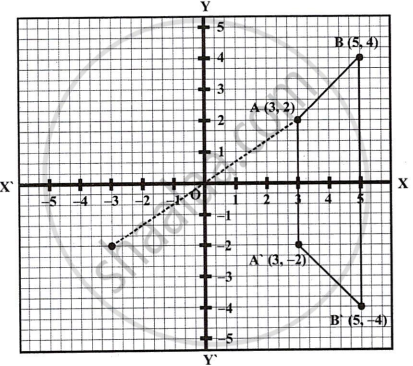Advertisements
Advertisements
प्रश्न
Attempt this question on graph paper.
- Plot A (3, 2) and B (5, 4) on graph paper. Take 2 cm = 1 unit on both the axes.
- Reflect A and B in the x-axis to A’ and B’ respectively. Plot these points also on the same graph paper.
- Write down:
- the geometrical name of the figure ABB’A’;
- the measure of angle ABB’;
- the image of A” of A, when A is reflected in the origin.
- the single transformation that maps A’ to A”.
उत्तर
- ∵ From the graph, we can say that
- ∵ Mx (x, y) = (x, –y)
Thus, Mx (3, 2) = (3, –2) and Mx (5, 4) = (5, –4) -
- an isosceles trapezium
- 45°
- ∵ Mo (x, y) = (–x, –y)
- Now A' (3, –2) `\implies` A" (–3, –2) ...[∵ My (x, y) = (–x, y)]

APPEARS IN
संबंधित प्रश्न
- Point P (a, b) is reflected in the x-axis to P’ (5, –2). Write down the values of a and b.
- P” is the image of P when reflected in the y-axis. Write down the co-ordinates of P”.
- Name a single transformation that maps P’ to P”.
The point (–2, 0) on reflection in a line is mapped to (2, 0) and the point (5, –6) on reflection in the same line is mapped to (–5, –6).
- State the name of the mirror line and write its equation.
- State the co-ordinates of the image of (–8, –5) in the mirror line.
The points P (4, 1) and Q (–2, 4) are reflected in line y = 3. Find the co-ordinates of P’, the image of P and Q’, the image of Q.
A point P (a, b) is reflected in the x-axis to P’ (2, –3). Write down the values of a and b. P” is the image of P, reflected in the y-axis. Write down the co-ordinates of P”. Find the co-ordinates of P”’, when P is reflected in the line, parallel to y-axis, such that x = 4.
Points A and B have co-ordinates (3, 4) and (0, 2) respectively. Find the image:
- A’ of A under reflection in the x-axis.
- B’ of B under reflection in the line AA’.
- A” of A under reflection in the y-axis.
- B” of B under reflection in the line AA”.
- Plot the points A (3, 5) and B (–2, –4). Use 1 cm = 1 unit on both the axes.
- A’ is the image of A when reflected in the x-axis. Write down the co-ordinates of A’ and plot it on the graph paper.
- B’ is the image of B when reflected in the y-axis, followed by reflection in the origin. Write down the co-ordinates of B’ and plot it on the graph paper.
- Write down the geometrical name of the figure AA’BB’.
- Name the invariant points under reflection in the x-axis.
The point P (3, 4) is reflected to P’ in the x-axis; and O’ is the image of O (the origin) when reflected in the line PP’. Write:
- the co-ordinates of P’ and O’.
- the length of the segments PP’ and OO’.
- the perimeter of the quadrilateral POP’O’.
- the geometrical name of the figure POP’O’.
A (1, 1), B (5, 1), C (4, 2) and D (2, 2) are vertices of a quadrilateral. Name the quadrilateral ABCD. A, B, C, and D are reflected in the origin on to A’, B’, C’ and D’ respectively. Locate A’, B’, C’ and D’ on the graph sheet and write their co-ordinates. Are D, A, A’ and D’ collinear?
Use graph paper for this question.
(Take 2 cm = 1 unit along both x-axis and y-axis.)
Plot the points O(0, 0), A(–4, 4), B(–3, 0) and C(0, –3).
- Reflect points A and B on the y-axis and name them A' and B' respectively. Write down their co-ordinates.
- Name the figure OABCB'A'.
- State the line of symmetry of this figure.
Use a graph paper for this question.
(Take 2 cm = 1 unit on both x and y axes)
- Plot the following points: A(0, 4), B(2, 3), C(1, 1) and D(2, 0).
- Reflect points B, C, D on the y-axis and write down their coordinates. Name the images as B', C', D' respectively.
- Join the points A, B, C, D, D', C', B' and A in order, so as to form a closed figure. Write down the equation to the line about which if this closed figure obtained is folded, the two parts of the figure exactly coincide.
